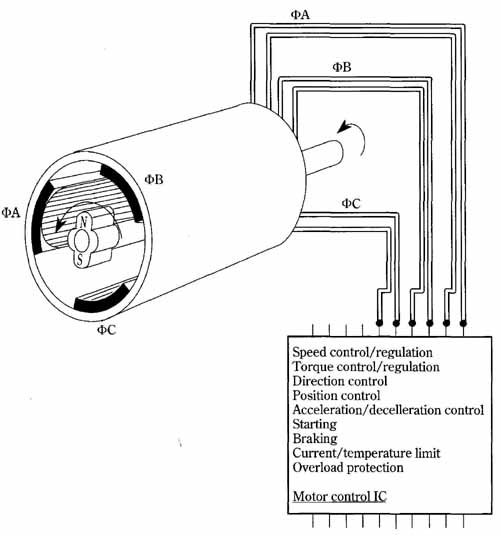AMAZON multi-meters discounts AMAZON oscilloscope discounts
. On the one hand, the ensuing discussions will appear as smooth and logical extensions of previously covered material. On the other hand, those who have be come accustomed to associate certain performance parameters of motors with specific machine designs might not find it “natural” to adopt a new mind set in which the control IC merits most attention. Indeed, in the latest phase of the evolving technology, it appears that the control IC is the high-priority device. Once the motor fulfills the basic requirement of converting electrical energy to mechanical energy, its role becomes more suggestive of an auxiliary components.
Interestingly, many of the newer techniques substitute digital-drive impulses in place of DC or sinusoidal ac excitation. This leads to dramatic improvements in timing, precision, and repeatability. Commutation, rectification, and the production of rotating fields are accomplished in silicon “brains.”
This being the case, the traditional electric-motor texts are likely to prove inadequate in dealing with newer applications. A surprising aspect of these advanced motor systems is that serious consideration is under way for integral horsepower de signs. In industry, these would vie for applications so long monopolized by three- phase induction motors. And, in electric vehicles, such motor systems would be particularly easy to tailor performance characteristics for optimum speed, efficiency, and range requirements.
The off-the-beaten-path motor concept
The classic motors described in this guide were designed specifically to be either dc or ac machines. Various operating characteristics ensued depending on whether a commutator and brushes were used, on the presence and connection of field windings, on the spatial distribution of windings, on the number of poles, and so on. Even after one complied with the basic laws of electromagnetism, much empirical work was necessary to accomplish trade offs that yielded a “civilized” motor—one with ad equate starting torque, but not with excessive starting current; one that could run smoothly at slow speeds; one that was quickly responsive to both frictional and inertial load changes; one that could be conveniently braked, etc.
When electronic controls were first associated with motors, it was often unnecessary to select a particular type of motor known to excel in a desired performance characteristic. To a considerable extent, any of the speed/torque characteristics could be obtained from a variety of motors if the feedback logic of the control circuit was appropriate. For example, a near constant speed vs. variable load characteristic could be obtained with dc series or shunt motors, or with ac universal or induction motors. A synchronous motor could be operated as a variable-speed machine despite its reputation as a constant-speed machine. And stepping motors could be scaled up in size and used to drive heavy loads with a variety of programmed characteristics. Then, stepping motors equipped with Hall-effect or optical position sensors gave rise to designs known as brushless dc motors. This gave further impetus for semiconductor firms to develop more sophisticated control ICs. These were endowed with a variety of programmable options so that the user could tailor motor performance to his or her needs.

FIG. 1 The “brains” of new-age motor design is in a control IC. Commutation,
timing, and speed/torque characteristics are determined by the logic
of a dedicated control-IC.
Motor control IC:
- Speed control/regulation
- Torque control/regulation
- Direction control
- Position control
- Acceleration/deceleration control
- Starting
- Braking
- Current/temperature limit
- Overload protection
This situation is illustrated by the fantasized motor structure of FIG. 1. With minor variations, this prototype motor can be operated as a conventional synchronous motor, as a stepping motor, or as a brushless dc motor. Such variations include the use of rotor position sensors, and perhaps a damper winding on the rotor to pro mote self-starting and to suppress hunting. However, a commutator and brushes are not needed; commutation, timing, and sequencing logic are the job of the control IC. Indeed, the Brie of demarcation between “alternating current” and “direct current” motors becomes, at best, fuzzy. Among its myriad of functions, the control IC can perform the roll of inverter. In so doing, it also frees performance from the fixed- speed constraint imposed by conventional ac sources. All in all, motor technology is becoming based on silicon as well as iron and copper. And, although thyristors, Darlingtons, MOSFETs and bipolar transistors continue to provide the muscle of motor systems, the dedicated control IC will increasingly assume the roll of a brain.